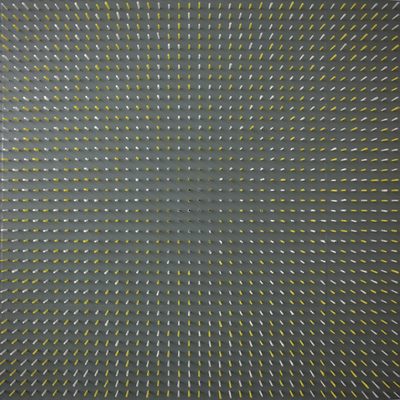
Description
In Wall Drawing 38, small rolls of colored tissue project from the surface of the wall. Viewers moving through the gallery space are confronted with shifting arrays of color. The sculptural quality of the work may seem to subvert Sol LeWitt’s original objective in making drawings directly on the wall: to make art “as two-dimensional as possible” by dispensing with the canvas.1 Having accepted the wall as his substrate, however, LeWitt also accepted the inherent eccentricities of the walls he was given as a “necessary part” of the finished work. “Different kinds of walls,” he claims in a statement entitled 'Wall Drawings', “make for different kinds of drawings.”2 In accordance with this assertion, the unique form of Wall Drawing 38 is a consequence of the wall conditions at the site of the original installation. In 1970, LeWitt was commissioned to create a new wall drawing on the occasion of the Tenth Tokyo Biennale, but the gallery space provided was paneled in pegboard that could not be removed or covered. To make use of the pegboard wall LeWitt devised the technique of tightly rolling squares of tissue and inserting them in the pegboard holes.
The instructions call for four walls. The first wall, omitted here, contains only white tissue. Each subsequent wall contains an additional color: the second wall has equal amounts of white and yellow tissue; the third has equal amounts of white, yellow, and red; and the fourth has equal amounts of white, yellow, red, and blue. The colors are randomly distributed. This arrangement reflects LeWitt’s interest in an “objective method of organization as a reaction against the idea that art was composed with great sensitivity by the artist throughout the production of the work.”3 Although LeWitt never employed the pegboard and tissue technique again in any other drawing, he notes in a statement about the work that it “was the source of much of [his] serial work.”4
Backstory
To insert the squares of tissue paper, the draftsmen devised a system involving wearing harnesses which hold plastic cups containing the tissue paper pieces. Before starting they sort the tissue paper into the cups, making sure that there are an equal number of squares of each color per wall. To cover the entire wall evenly the draftsmen situate themselves both on and under scaffolding. Once in place, they role the tissue paper tightly around skewers, using the skewers to guide the paper into the holes.Details
- Work Date:
- April 1970
- Medium:
- Colored tissue papers, gray pegboard walls
- Credit Line:
- Panza Collection